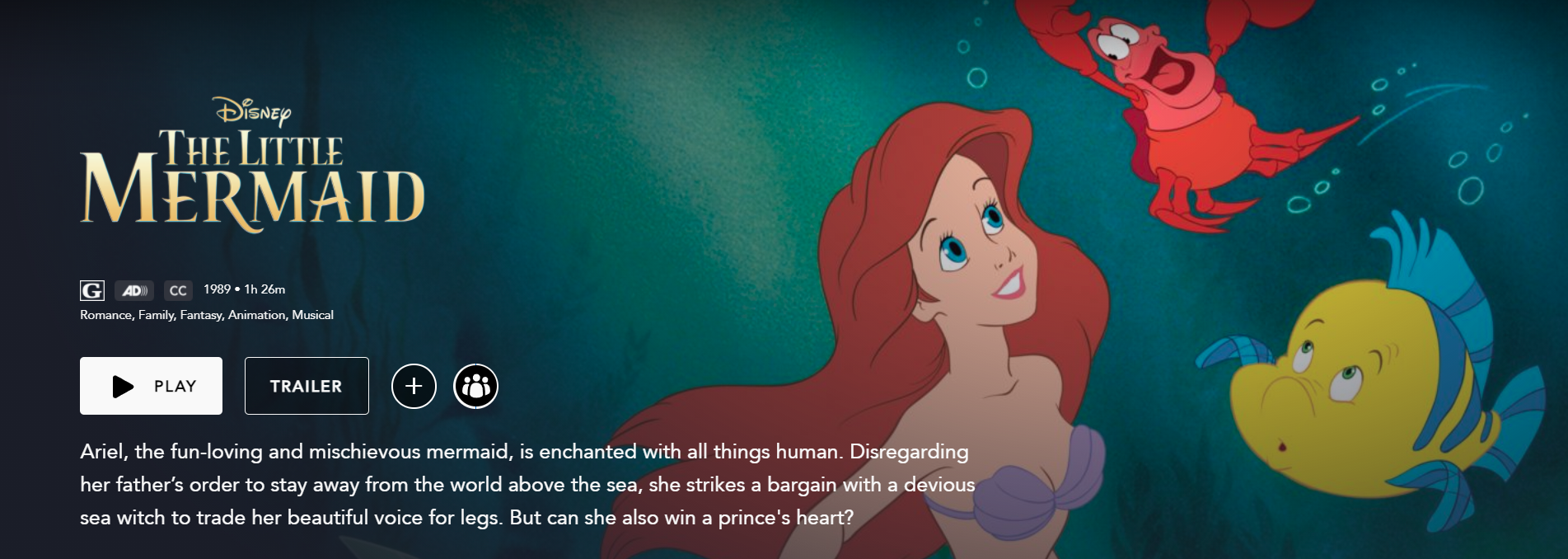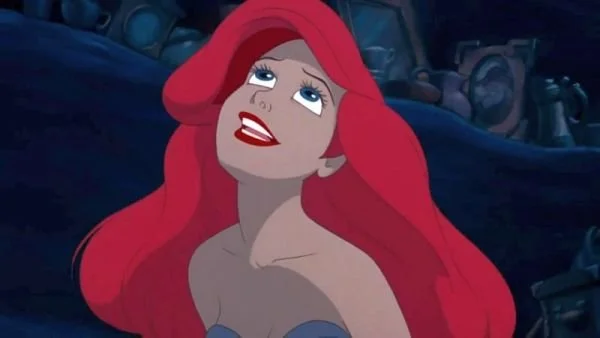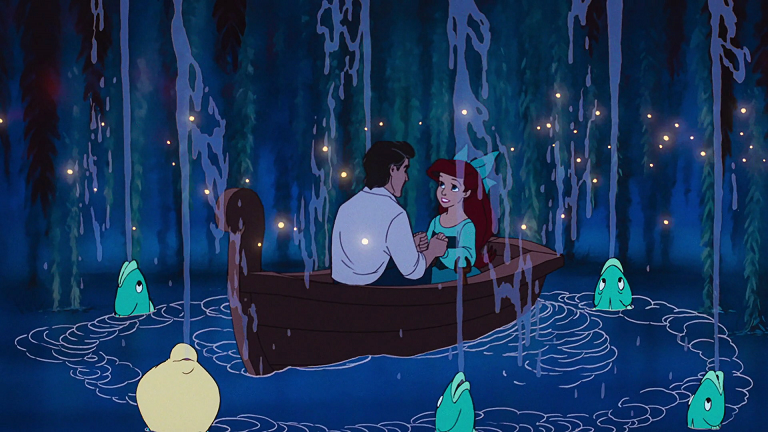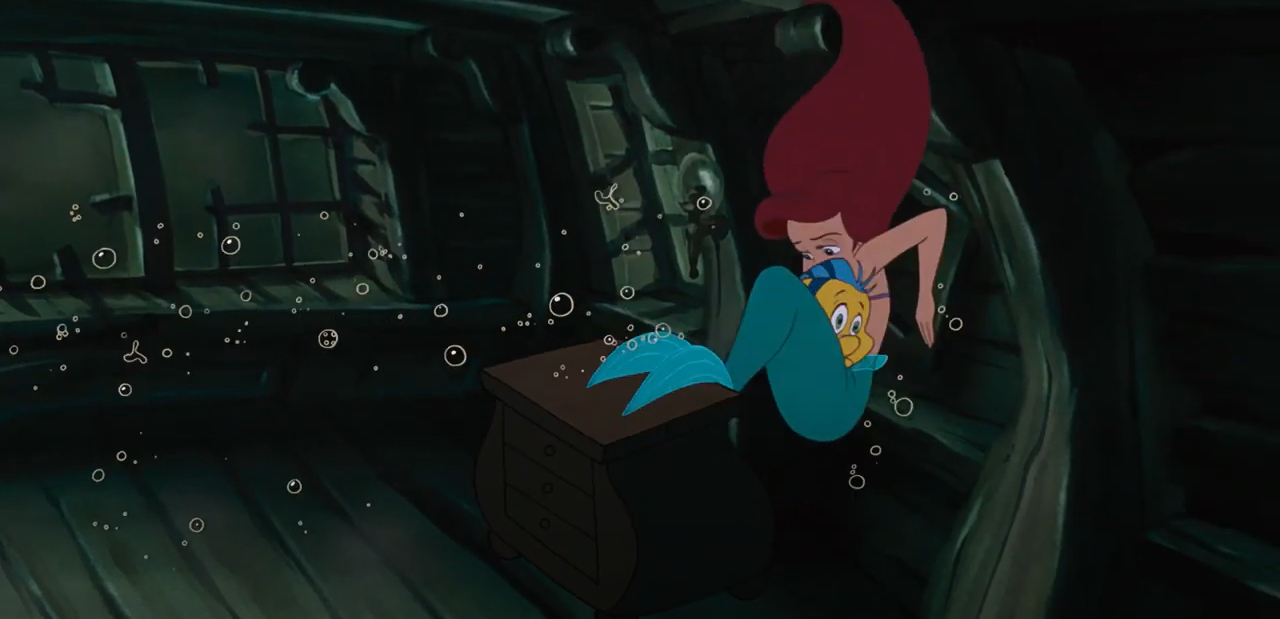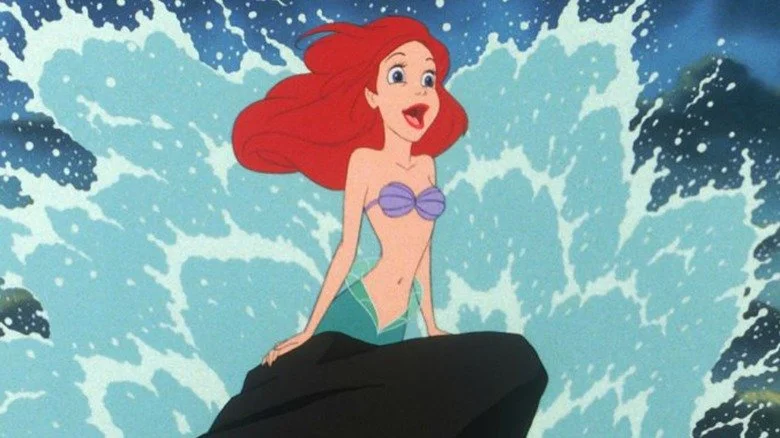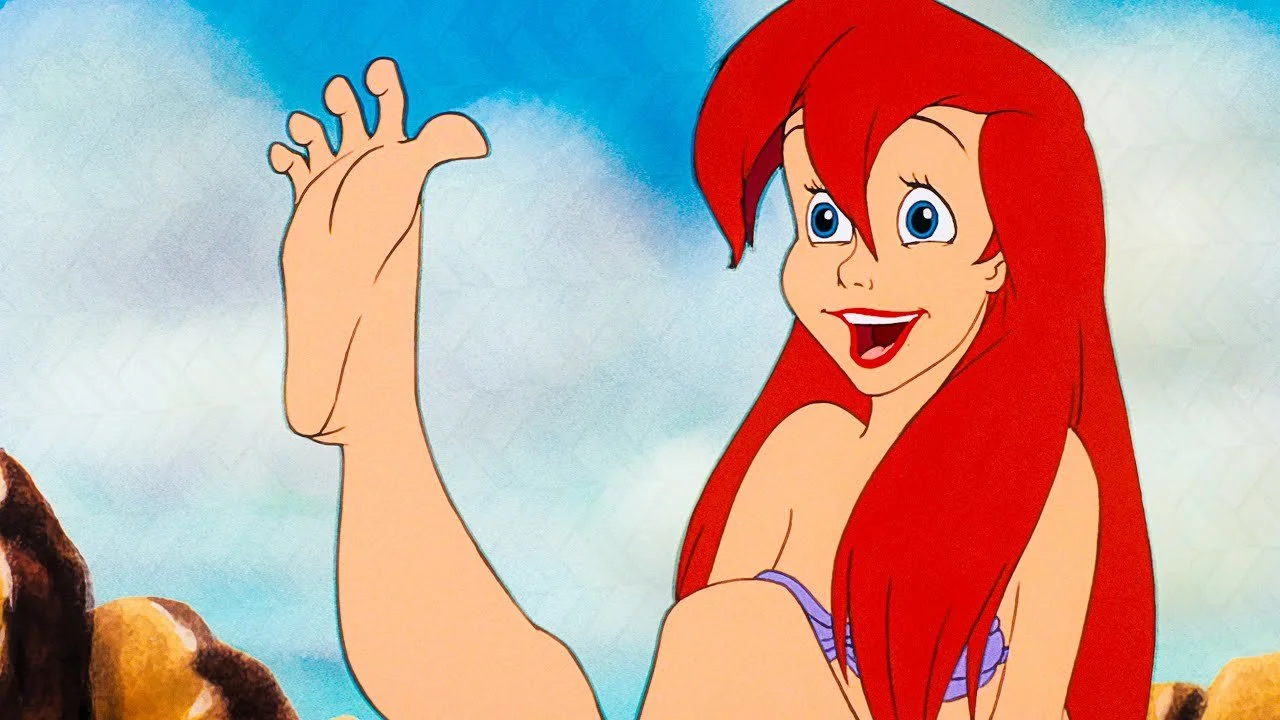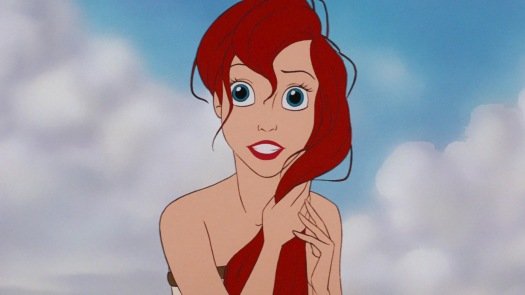Review: The Little Mermaid (DMC #86)
This week we’re devotin’ full time to floatin’ under the sea with The Little Mermaid, the 86th movie in our challenge! It’s also the beginning of an era we’ve been looking forward to reviewing since we started this challenge, so we’re excited to dive in. Our synopsis is available below if you need some catching up. For the rest of you, swim on down to our review.
Synopsis
A young prince named Eric is enjoying a day sailing on his ship. His crew say the perfect day is owed to King Triton, leader of the merpeople that live below the ocean. Deep underneath the waves at King Triton’s palace home of Atlantica, Triton’s advisor and court composer, a crab named Horatio Thelonious Ignacious Crustaceous Sebastian, prepares to conduct his newest concert starring Triton’s seven mermaid daughters. However, the youngest daughter, Ariel, is nowhere to be found. Ariel, who is fascinated by the human world above, explores a sunken ship with her best friend, a fish named Flounder, in search of human artifacts to add to Ariel’s collection. After narrowly escaping the jaws of a shark, they visit their seagull friend, Scuttle, above the surface, where Scuttle provides incorrect information about the artifacts, such as calling a fork a “dinglehopper” and claiming humans use it to comb their hair. When Scuttle inadvertently reminds Ariel of the concert she missed, she and Flounder immediately swim back home. Meanwhile, the sea witch, Ursula, watches Ariel through the eyes of her symbiotic pet eels, Flotsam and Jetsam. Ursula plots to take the throne from Triton and thinks Ariel is the key to this plan. Back at Atlantica, Triton scolds Ariel for running off and for her obsession with humans, who Triton sees as dangerous. He orders Sebastian to watch Ariel for any disobedient behavior. Sebastian follows Ariel and Flounder to Ariel’s secret grotto. Ariel sings of her wish to be part of the human world above. Sebastian, aghast at her collection of human artifacts, tries to take Ariel home, but she’s distracted by a ship sailing overhead. Ariel swims up to the ship where a party is being held for Prince Eric’s birthday. She is immediately smitten with the handsome prince. Eric’s steward, Grimsby, presents an unflattering statue of Eric as a birthday present. Later, he tells Eric that at his age he should begin settling down and getting married. Eric argues that he’ll get married once he finds the right girl. A hurricane approaches and lightning strikes the ship, setting it ablaze. Eric and the crew abandon the ship, though Eric realizes his dog, Max, is still aboard. He rescues Max, but gets caught in a loose floorboard and is thrown unconsciously into the turbulent water when the ship explodes after igniting fireworks on board. Ariel saves Eric from drowning and takes him to shore. The next morning, she watches over Eric as he lays on the beach. She sings to him, repeating her words of wishing to be part of his world before swimming away to avoid being discovered. Ursula watches these events via her eels and is ecstatic that Ariel has fallen not just for a human, but a human prince, which makes her plans easier.
Ariel is seen happily humming to herself. Her sisters realize she is in love and tell their father so. A worried Sebastian tries persuading Ariel that life is much better under the sea than up in the human world. Flounder whispers to Ariel and they leave before Sebastian notices. A seahorse arrives with a message for Sebastian: he’s to see Triton, who is curious to know who Ariel has fallen for. He slyly asks Sebastian if he knows anything about Ariel. Misunderstanding Triton’s question, Sebastian reveals that Ariel went to the surface and rescued a human the other night, enraging the sea king. At Ariel’s grotto, Flounder surprises Ariel with the statute of Prince Eric which had fallen to the sea floor. Triton arrives at that moment and confronts his daughter. After hearing her say she loves Eric, Triton destroys her collection of artifacts, including the statue, and leaves his daughter heartbroken. Flotsam and Jetsam arrive and convince Ariel to visit Ursula, who they claim can help her. At Ursula’s lair, the sea witch makes a deal with Ariel to transform her into a human for three days in exchange for the mermaid’s voice. Ariel must receive a “kiss of true love” from Eric before the three days are up. If she succeeds, she will remain a human forever, otherwise she will be turned back into a mermaid and belong to Ursula permanently. Ariel agrees and is turned into a human while Ursula takes her voice and seals it inside a shell necklace. Flounder and Sebastian, who followed Ariel, help her get to the surface and onto a beach right by Eric’s castle, where she excitedly tries out her new legs. Scuttle visits the group and doesn’t immediately figure out what’s new about Ariel. A horrified Sebastian suggests that they convince Ursula to renege on the deal before Triton can find out, but he changes his mind when he sees Ariel’s saddened face and realizes she would miserable for the rest of her life if she didn’t at least try to make this work. Instead, he opts to help her find Eric, and Scuttle “helps” Ariel get dressed in the remnants of an old sail. Eric and Max are also on the beach; Max, who had met Ariel briefly on the ship, recognizes her scent nearby and takes Eric to her. At first, Eric thinks he’s found the girl who saved him, but when she can’t speak he concludes he must be wrong. Eric takes Ariel back to his castle to get cleaned up. She meets with him and Grimsby for dinner later, where Eric appears taken with how beautiful Ariel looks cleaned up and in a dress. Ariel picks up a fork and begins combing her hair. At Eric and Grimsby’s perplexed faces, she immediately stops. Sebastian experiences trouble of his own when he finds himself in the castle’s kitchen. He narrowly avoids being cooked by Chef Louis, who develops an antagonistic relationship with the crab. At dinner, Grimsby suggests Eric take Ariel out the next day to see the kingdom, which Ariel eagerly agrees to. She also spots Sebastian on Grimsby’s plate and helps him escape before he can be eaten. Meanwhile, Triton is dismayed when no one knows where Ariel and Sebastian are and blames himself for his daughter’s disappearance.
The next day, Eric takes Ariel on the promised tour. The two bond and grow closer together while Flounder, Sebastian, and Scuttle keep each other updated on whether they have kissed yet. By the end of the second day, the three become concerned. Eric takes Ariel out on a rowboat, where Sebastian takes matters into his own hands and enlists the help of nearby animals to set a romantic mood. With Sebastian’s help, Eric learns Ariel’s name. The two are about to kiss when they are thwarted by Flotsam and Jetsam; Ursula had been watching the whole time. Angered that Ariel almost succeeded, Ursula transforms herself into a beautiful human woman named Vanessa. Later that night, Grimsby convinces Eric to give up looking for his dream girl and instead pursue a relationship with Ariel. Eric is about to go up to Ariel’s room when he hears the sound of Ariel’s voice singing the same melody he heard when she saved him. Eric sees a young woman walking along the beach. As he watches, Ursula disguised as Vanessa uses her shell necklace to hypnotize Eric and make him forget about Ariel. On the morning of the final day, Scuttle eagerly tells everyone that Eric is getting married, but Ariel discovers that it’s to the mystery woman, Vanessa. The wedding is planned to be at sundown that day, and Ariel later tearfully watches as Eric and Vanessa sail off on a wedding barge. Scuttle flies near the barge and discovers Vanessa’s real identity after overhearing her privately celebrating her victory. He informs Ariel, Flounder, and Sebastian, and Flounder swims Ariel to the barge as fast as he can. Sebastian says he will inform Triton what’s happened while Scuttle rallies nearby sea animals to help him stall the wedding.
Eric and Vanessa are about to be pronounced married when Scuttle arrives with the animals. Chaos ensues as the guests disperse and the animals attack Vanessa. Max bites her, causing the shell necklace to fly off and land right near Ariel, who had just climbed onto the barge. The shell breaks and restores Ariel’s voice. Eric is freed from his enchantment and finally realizes Ariel is indeed the girl he was looking for. They attempt to kiss, but the sun goes down before they can. Ariel turns back into a mermaid and is pulled back into the ocean by Ursula, who had also transformed back. Triton confronts Ursula and demands Ariel’s release. When he can’t destroy the contract they made, he makes a new deal with Ursula to take Ariel’s place as Ursula’s prisoner. In doing so, he gives up his trident and is transformed into a polyp. Ursula takes control of the trident and the crown, becoming the new ruler over Atlantica. Eric, who left the barge and chased after Ariel and Ursula underwater, shoots a harpoon at the sea witch. He is captured by Flotsam and Jetsam and nearly killed by Ursula’s trident, but Ariel redirects the trident to hit the eels, killing them instead. Ariel and Eric escape to the surface, but an enraged Ursula uses the trident to grow to a monstrous size. She creates storms and causes sunken ships to rise to the surface. Ariel falls into a maelstrom while Eric climbs aboard one of the ships, steering it towards the sea witch. Ursula mocks Ariel and is about to kill her when Eric impales Ursula with the ship’s broken bowsprit. With Ursula dead, Triton is transformed back into a merman, as are many other polyps who were Ursula’s prisoners. A little later, an exhausted Eric washes ashore while Ariel watches him. Triton realizes that Ariel truly loves Eric and uses his trident to permanently transform Ariel into a human. Eric wakes up just in time to see Ariel rejoin him on land, and the two finally share a kiss. They are later married and Ariel shares a farewell to her family and friends as they watch Ariel and Eric depart on the wedding barge.
Thoughts Before Watching
Megan: THE LITTLE MERMAID!!! I’m so excited for this one! This is the first movie I remember seeing at a drive-in theater (I don’t know if I saw it in 1989, but I do remember wearing those footie pajamas little kids wear, so I was definitely little). According to my mom, this was the movie I watched on repeat once we got it on VHS, which probably explains why I feel like I’ve memorized so much of the movie, even though I haven’t watched it in I don’t know how many years. I already know there’s some not-too-great stuff in here from a feminist perspective (a teen girl literally giving up her voice to get a guy, for one thing), but it also has a lot of good stuff going for it, too, like the amazing soundtrack! I’m eager to see this one again.
Kevin: I’m so glad we have finally made it to the Disney Renaissance! To be honest, when Megan first came up with this project nearly two years ago, I was most interested knowing that it meant we would one day get to this era. It’s been a fun project up to now and the wait has been completely worth it. It’s no exaggeration to say that these next few months reviewing the Renaissance films will be my most favorite yet. As for the movie that started this period, I’ve always liked The Little Mermaid, but as a kid I much preferred the soundtrack to the actual movie. It was around my college years that I developed a deeper appreciation for the film and its legacy. It’s not something I re-watch on a regular basis, yet it’s always a good time when I do watch it. I last saw this several years ago when I did my own Disney marathon and I’m looking forward to seeing if I come away with anything new about this. Let’s go!
Thoughts After Watching
A “return to form” but with a new way forward
Kevin: The Little Mermaid was rightfully and deservedly lauded as the studio’s return to making films the way they were when Walt was at the helm. It’s important to note, though, that the film marks this “return” in a way that clearly shows the studio moving forward. It’s difficult to discuss just one thing it gets right when it does a great job in almost every way; the animation, the story, the music, the characters—the studio delivered on all of these. But not only did they create a film that reminds viewers of the Silver and Golden Ages of Disney, the film does so while introducing innovative ways to tell stories.
Naturally, I want to begin with the animation. The Little Mermaid is a bit unique in this area because it’s both the end of an era as well as the beginning of a new one. The film would end up being the very last feature released by Walt Disney Animation Studios to use the Xerox method that had been in use for nearly 30 years (DuckTales the Movie also uses the Xerox method but was released by Disneytoon Studios). Time has been kind to the animators here; the line art in the film is noticeably different compared to where the method got its start in One Hundred and One Dalmatians. Heck, it’s even noticeable compared to Oliver and Company despite that movie being released the year before (not to mention both films were worked on at the same time). After nearly three decades of work, the overall animation in the first Disney Renaissance film is the most fluid we’ve seen since Sleeping Beauty. A big part of this success can be credited to the fact it was the first film in many years to use live actors and actresses as motion references, a practice that had been more or less abandoned since Walt’s passing. We can see this practice was successfully implemented because the character animation is arguably the best we’ve had since The Jungle Book. A big highlight is pretty much everything that happens during the underwater scenes. I love how Ariel’s hair moves when she’s underwater, showing just how much care the animators had in order to make it as real-looking as possible. The CGI in this movie is another highlight; it would be the first to use the Pixar program known as CAPS (Computer Animation Production System) that eventually replaced the traditional hand-painted style of animation. In fact, The Little Mermaid would be the last film released by Disney Animation Studios to use the method (not including DuckTales the Movie for the reason mentioned before). Though the film marked the end of an older animation method, it also began something new.
Kevin: The music, story, and characters are something rather new in this film. That is, they are woven so tightly together that they’re almost integral to each other. Past films might have some good music and subpar characters and/or story, or vice versa. Occasionally all the elements worked together, but not to the strong degree they do here. In this film, these things actually play off each other. Like the animation, the story is a return of sorts to the old Disney stories. It’s a fairy tale with some action, some adventure, some music, and some romance. If someone didn’t know when the films were released, they might think The Little Mermaid was made around the same time as Cinderella or Sleeping Beauty just off the story alone. But the movie tells its story with a more modern approach, or at least as modern as it could be in the late ‘80s/early ‘90s. As said before, the music is intertwined with the characters and story, a feat credited to the film’s lyricist, Howard Ashman. We’ve mentioned him before on this blog, and it’s not an exaggeration to say that Ashman, along with his composer partner Alan Menken, forever changed the way music was written for Disney films. Ashman, a gay man with experience writing musicals, felt that writing music as a way to move the story forward similar to Broadway-style plays was the best approach. Many people have pointed out that a lot of the earliest Renaissance films contain elements that members of the LGBTQ community identify with. For example, it’s well known by now that Ursula was inspired by famous drag queen Divine. Ashman has been cited as an inspiration for young children who identified with his lyrics, such as those found in “Part of Your World.” It’s clear why Ashman wrote the lyrics the way he did, and this is why I said the movie tells its story in as modern of an approach that it could in 1989. There is a huge contrast between the style of music in The Little Mermaid (and later Renaissance films) and the that of older Disney movies. While I do enjoy many of the soundtracks of these older movies, there are often times the songs feel a bit out of place and unneeded for the story being told. Ashman and Menken are noted to have believed that songs should feel they come naturally, as if the character singing is doing so because there’s no other way to express their current emotion except through song. The songs now have a narrative purpose and no longer feel out of place. They now feel like perfectly natural responses to the situation the character is dealing with. As time moved forward and more young LGBTQ folk began to come out and express themselves more openly, it seems very clear that the method Ashman and Menken devised came at a good time. Unlike many films of Disney’s past, I’d argue newer films, starting with The Little Mermaid, were better at crafting stories audiences could relate to.
The music is 10 out of 10!
Megan: I just have to second what Kevin has already said about the music in this film—it is SO GOOD! The songs are so catchy, with fun numbers like “Under the Sea” and “Kiss the Girl,” and an excellent villain song in “Poor Unfortunate Souls.” Every song from the film is on constant rotation in my Disney playlist and I love belting them out! Speaking of which, it’s because I listen to the songs on my playlist so much more frequently than I rewatch the film that I had completely forgotten that Ursula’s “Poor Unfortunate Souls” number was actually shortened a wee bit for the soundtrack version. In the film, Ursula and Ariel have a bit more dialogue going over the details of their arrangement in between the lyrics of the song, but the soundtrack version trimmed the dialogue to just the essentials to put more focus on the song itself. It was actually a pleasant surprise to rewatch the film this time around and realize that there was a part of the film I’d forgotten about until this latest viewing.
This is also the first time we get the storytelling song formula pulled from musical theater that will be used again and again in later Disney films (thank you Howard Ashman and your musical theater influence!). We begin with the opening number, “Fathoms Below,” which sets the stage and draws us into the story. Then we have the “I want” song with Ariel’s “Part of Your World.” The big showstopper number (which also featured prominently in the ads I remember seeing for this film) is Sebastian’s catchy “Under the Sea.” Though everyone usually attributes the villain song to Ursula’s “Poor Unfortunate Souls,” this film actually has a second villain song with “Les Poissons” featuring the albeit lesser villain, Chef Louis. And of course, this formula wouldn’t be complete without the love song, “Kiss the Girl.” This storytelling song formula would become synonymous with the films of the Disney Renaissance.
Romance still needs a little bit of work
Kevin: As much as I love “Kiss the Girl,” the romance in this movie is still a bit lackluster. To give credit where credit is due, the more natural bond that forms between Ariel and Eric during the three days Ariel doesn’t have her voice is actually done quite well. At the very least, there is reason to believe that these two characters could indeed fall in love through their shared experiences, however quick they might be. The problem with the romance is why Ariel ended up trading her voice for legs in the first place. The romance begins much in the same way it does in earlier Disney films—through one first impression. Ariel is smitten with Eric at first glance and Eric is mesmerized by her voice and a hazy look at her after waking up. Ariel’s declaration of love for Eric is a bit strange when you realize she got one good look at the prince before she soon had to rescue him from drowning. This is a strong, shared experience for sure, but doesn’t quite scream romantic. At this point, she doesn’t know anything about him, which becomes funny after she exposes her lack of self-awareness when she later argues with her father that he doesn’t know Eric and shouldn’t judge him so harshly. Nearly every comment Ariel makes about Eric has to do with how handsome he is and nothing to do with his personality, so she really has no room to act as if she knows Eric either. From a realistic view, it could be agued that at sixteen, Ariel is simply a lovesick teenager. However, the film spends its entire plot around this romance and doesn’t criticize it at all, so we’re meant to root for these two. Like Ariel, Eric is not without some criticism for his view. He’s determined to find the girl who rescued him and marry her, basing his view entirely on her beautiful voice and a non-distinct look at her. The irony, of course, is that the girl is in front of him the whole time. This said, Ariel and Eric do get points for the above mentioned experience they shared during those three days, with Ariel getting to actually know Eric for just the tiniest bit more than his good looks, and Eric for eventually deciding to “give up” on finding his rescuer and choose Ariel (until Ursula screws things up). The way the romance is formed is as one dimensional as it was in earlier movies, showing that there’s still some work to be done. Luckily, the movies that followed would handle their romances a little better.
A Bechdel test win, but…
Megan: Thankfully this film about a female character passes the Bechdel test with more than one conversation between two named female characters (though there are still too few female-to-female conversations for my liking). First we have Ariel’s sisters talking to each other about Ariel being in love. Though Triton assumes Ariel is in love with a merman, her sisters don’t verbalize any assumptions about who Ariel is in love with, and Ariel, not her love interest, is the focus of their conversation. We also see Ursula talking to Ariel. Granted, a lot of their conversation is about getting a man, but there are a few lines of song or dialogue that don’t directly focus on that. We also have the brief moment between a now mute Ariel and the maid, Carlotta, who chatters away while helping Ariel bathe and change out of her dress made of sail cloth. Though it’s hard to call it a conversation since Ariel no longer has a voice in this scene, Carlotta does keep her conversation focused on Ariel and says nothing of Eric or the other male characters. Her conversation is followed by the curious chatter of the other maids as they do laundry. Sure, these maids are unnamed, and their conversation does stray to Prince Eric and his search for a suitable wife, but the conversation begins with curiosity about Ariel. The one odd thing of note in all of this, however, is that none of these Bechdel test-passing conversations are directed by the film’s protagonist, Ariel. Sure, the conversations are often about Ariel, but aside from her dealings with Ursula, Ariel is a mute participant or a non-participant in these conversations. The only conversations she does initiate are with male characters.
Ariel’s lack of participation in Bechdel test-passing conversations echoes the unfortunate reality of this story—at its core, this is a story about a young woman who gives up her voice for a man. It’s not totally Disney’s fault. The plot of this film’s source material, Hans Christian Andersen’s The Little Mermaid, contains the same ill-fated decision (though, for that particular little mermaid, her story didn’t have quite the same Disney fairytale ending). Surprise, surprise—the original tale was written by a man. I get that what he was going for was to show just how far a character was willing to go for a chance at love. (And in the case of the original tale, there at least seemed to be a moral of “don’t do that because you’ll end up heartbroken and dead” rather than Disney’s happy ending which unfortunately seems to frame losing her voice as an unfortunate sacrifice made along the way to attaining true love). However, the idea of a woman giving up her voice, her agency, in hopes of winning a man’s affection just seems, well, awful. Even more so because in 1837, when the tale was originally published, women had even fewer rights or opportunities than men compared to how things were in 1989 when this film came out. It makes me wonder, how might the story have been different if a woman had written it? Would it instead have been the prince who had to make a deal with the sea witch? If the story still were to require an agreement between the mermaid and the sea witch, what would a woman think is a worthy sacrifice for a chance at love?
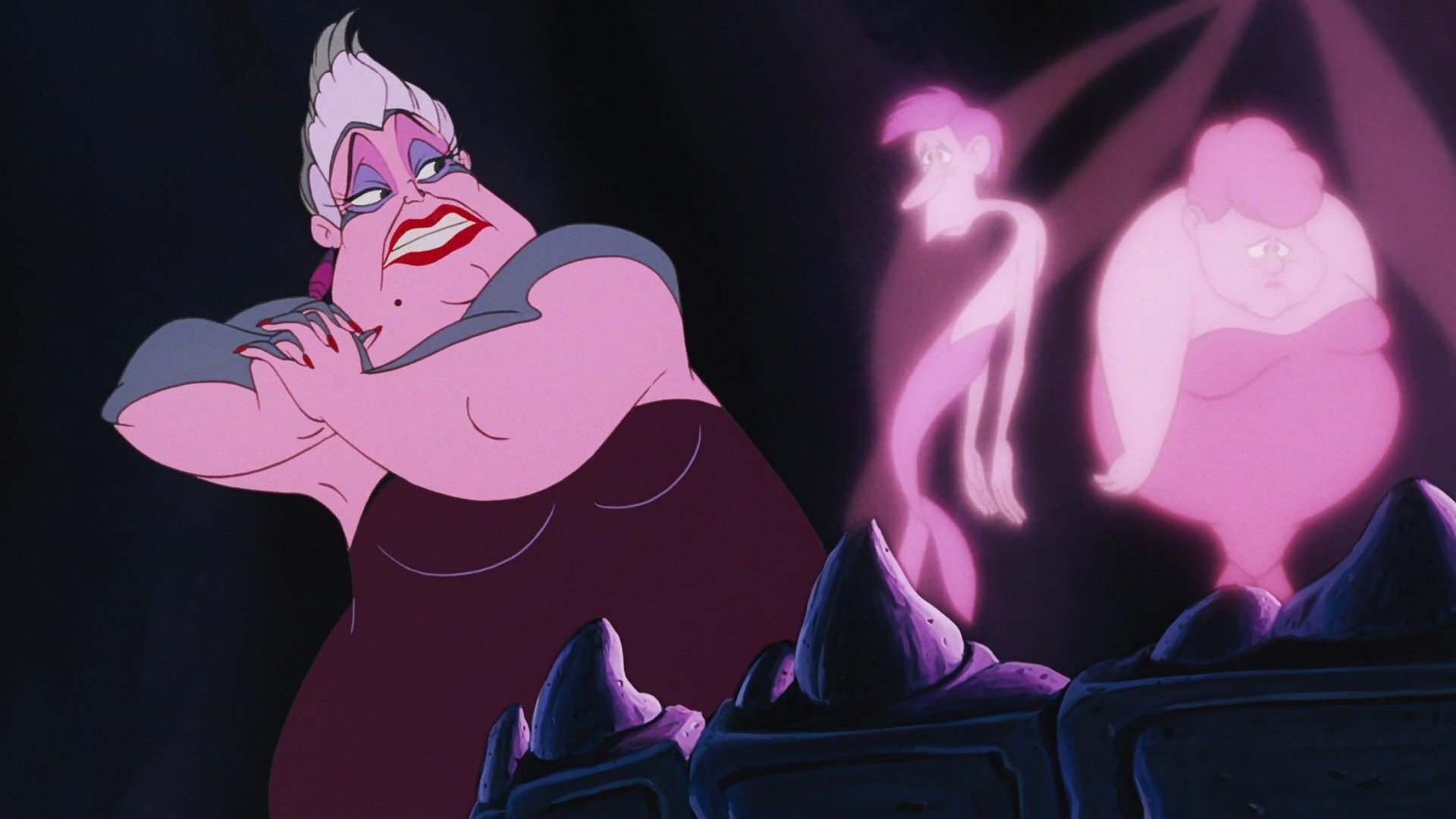

Sexism persists and body image issues abound
Megan: The other downside to this film is how it portrays men and women, especially when it comes to their bodies. Nothing exemplifies this better than the sample “poor unfortunate souls” Ursula shows to Ariel.
This one longing to be thinner
That one wants to get the girl
And do I help them?
Yes, indeed
The sample woman is plump and wants to be thinner. The sample man is scrawny and “wants to get the girl.” Both of these unfortunate merfolk have fallen prey to unattainable beauty standards and sought Ursula’s help in attaining the “perfect” body, believing (at least in the merman’s case) that having the perfect body will get them the love they so desire. When the woman transforms, she’s not only “thinner” with an hourglass figure, but her hair is longer and more voluminous, and her facial features have been heightened to fit beauty ideals. For the man, he’s no longer scrawny, but bursting with gigantic pectorals and biceps, and a strong, protruding chin. Their transformation works—for a moment—but when neither is willing to pay the price of that perfection and Ursula’s match-making, they’re doomed to be shriveled up little creatures in Ursula’s “garden.” It’s a bit of a metaphor for how things are in the real world. Those who are willing to sacrifice anything to force their body to fit an unattainable beauty ideal will eventually suffer the consequences. However, rather than delivering on this message, the film continues to reinforce stereotypical beauty standards for men and women. Ariel, the hero, is thin with an hourglass figure in both mermaid and human forms. Ursula, the villain, is fat. Good=thin. Bad=fat. The male characters suffer a similar fate. King Triton, the most powerful merman of the sea, has a chest and arms that not even Arnold Schwarzenegger could attain. Prince Eric, though a bit closer to reality in his dimensions, is similarly fit with broad shoulders and a narrow waist. In contrast, Grimsby, the comic relief and subordinate male character, is scrawny and angular with a nose that’s almost bigger than his waist. Here, broad shoulders, buff arms and chest=hero/leader/power/male love interest. Anything less=weakness. Then of course there’s Chef Louis, another villain who’s fat, further reinforcing that bad=fat. Maybe you’re thinking, “so what?” Well, let me ask you this: what if we flipped it? What if Ursula’s sample merfolk started out in their “after” forms and wanted to reach their “before” forms, with the woman wanting to be fatter and the man wanting to be thinner? What if Ariel was drawn as fat and Ursula was drawn as thin? What if King Triton and Grimsby swapped body types? Feels a little weird, right? But it’s only weird because our society has been inundated with images of male heroes looking buff and female heroes looking thin but curvy. That has become our “norm” but it’s only the norm because society has made it that way. My hope is that as newer animated films continue to reflect the changing views of our culture, we’ll start to see more diversity in body types as well as cultural and racial diversity.
What’s Ariel’s workout regimen?
Kevin: This section is just for a bit of fun, but ever notice just how incredibly strong Ariel is? During the shark attack early on in the film, she uses her tail to “kick” a large table at the approaching shark. Adrenaline was likely playing a factor, but it’s still impressive. She later pulls aside a large stone to gain access to her grotto. It’s been pointed out before that pulling that stone should have technically been difficult if not impossible to do underwater. But Ariel makes it look like child’s play. We see Ariel’s strength later on when she manages to climb up Prince Eric’s ship using just her arms (at least I assume it’s just her arms. Can she use her tail as a way to gain footing?) and when she manages to pull Eric up through the water with one arm to save him. Keep in mind he was unconscious and was likely just dead weight at that time. I presume sixteen years of swimming every day is what has given Ariel her amazing strength. Or maybe merpeople are just naturally born with superior strength. Either way, I think it’s fair to say you clearly do not want to get on the bad side of a merperson in this movie.
Is mermaid hair magic?
Megan: Something that many fans have pointed out before is that when Ariel springs out of the water while singing “Part of Your World (Reprise)” after rescuing Prince Eric, her hair looks absolutely amazing for being soaking wet. Any girl who’s ever tried to recreate Ariel’s hair flip in the pool knows that it’s not nearly as glamorous as the animated version would make it seem. At first, I attributed this to animator error (or animator choice to make a character look recognizable and attractive instead of realistic), but then I noticed that when Ariel becomes human, her wet hair acts as wet hair should. It hangs heavily over her shoulders. It’s messy when she tries to pull it back. Is this because she’s human and no longer has mermaid magic to keep her hair full of volume even when it’s soaking wet? If mermaid hair really is magic, it would definitely explain why no mermaid’s hair looks at all tangled after a lifetime of living under water.
Final thoughts
Kevin: I really do like this movie a ton. It isn’t isn’t one of my top favorites, but it is very, very good. In many ways, this movie is objectively better than the last fantasy musical Disney put out, which was Sleeping Beauty, but I just personally like that one a little more. That said, the immense success of the The Little Mermaid cannot be overstated. It may very well be the most popular film to come out of the Renaissance, and it is certainly one of the most popular in all of Disney’s catalog. What the film accomplishes makes it stand out from its predecessors and it set the path Disney would follow for the next ten years. The result was what is arguably the best era of Disney animated films.
Megan: As for me, I’m still a big fan of this movie, even in spite of the not-so-feminist bits of the story. I may not watch it as obsessively as I did as a toddler when the film came out, but it’s still a hit in my book. The music is great, the story and plot structure work incredibly well, and the characters are so well developed I’ll happily follow them on their adventures.
